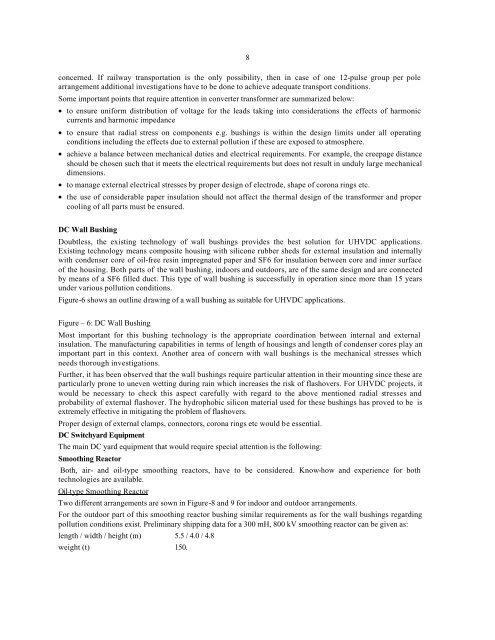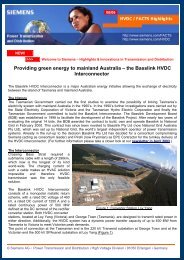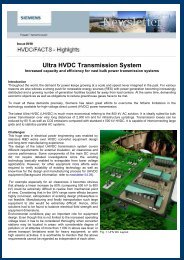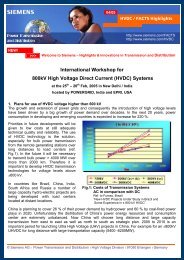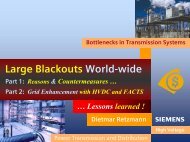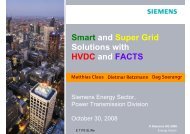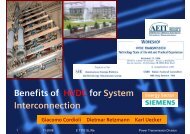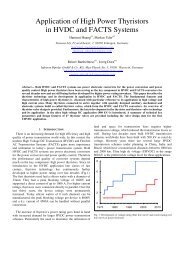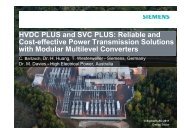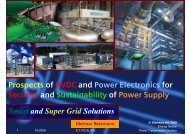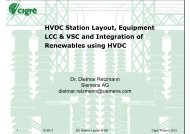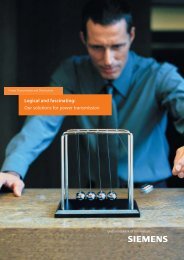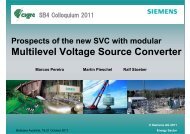Technology and Development of 800 kV HVDC ... - Siemens
Technology and Development of 800 kV HVDC ... - Siemens
Technology and Development of 800 kV HVDC ... - Siemens
Create successful ePaper yourself
Turn your PDF publications into a flip-book with our unique Google optimized e-Paper software.
8<br />
concerned. If railway transportation is the only possibility, then in case <strong>of</strong> one 12-pulse group per pole<br />
arrangement additional investigations have to be done to achieve adequate transport conditions.<br />
Some important points that require attention in converter transformer are summarized below:<br />
• to ensure uniform distribution <strong>of</strong> voltage for the leads taking into considerations the effects <strong>of</strong> harmonic<br />
currents <strong>and</strong> harmonic impedance<br />
• to ensure that radial stress on components e.g. bushings is within the design limits under all operating<br />
conditions including the effects due to external pollution if these are exposed to atmosphere.<br />
• achieve a balance between mechanical duties <strong>and</strong> electrical requirements. For example, the creepage distance<br />
should be chosen such that it meets the electrical requirements but does not result in unduly large mechanical<br />
dimensions.<br />
• to manage external electrical stresses by proper design <strong>of</strong> electrode, shape <strong>of</strong> corona rings etc.<br />
• the use <strong>of</strong> considerable paper insulation should not affect the thermal design <strong>of</strong> the transformer <strong>and</strong> proper<br />
cooling <strong>of</strong> all parts must be ensured.<br />
DC Wall Bushing<br />
Doubtless, the existing technology <strong>of</strong> wall bushings provides the best solution for U<strong>HVDC</strong> applications.<br />
Existing technology means composite housing with silicone rubber sheds for external insulation <strong>and</strong> internally<br />
with condenser core <strong>of</strong> oil-free resin impregnated paper <strong>and</strong> SF6 for insulation between core <strong>and</strong> inner surface<br />
<strong>of</strong> the housing. Both parts <strong>of</strong> the wall bushing, indoors <strong>and</strong> outdoors, are <strong>of</strong> the same design <strong>and</strong> are connected<br />
by means <strong>of</strong> a SF6 filled duct. This type <strong>of</strong> wall bushing is successfully in operation since more than 15 years<br />
under various pollution conditions.<br />
Figure-6 shows an outline drawing <strong>of</strong> a wall bushing as suitable for U<strong>HVDC</strong> applications.<br />
Figure – 6: DC Wall Bushing<br />
Most important for this bushing technology is the appropriate coordination between internal <strong>and</strong> external<br />
insulation. The manufacturing capabilities in terms <strong>of</strong> length <strong>of</strong> housings <strong>and</strong> length <strong>of</strong> condenser cores play an<br />
important part in this context. Another area <strong>of</strong> concern with wall bushings is the mechanical stresses which<br />
needs thorough investigations.<br />
Further, it has been observed that the wall bushings require particular attention in their mounting since these are<br />
particularly prone to uneven wetting during rain which increases the risk <strong>of</strong> flashovers. For U<strong>HVDC</strong> projects, it<br />
would be necessary to check this aspect carefully with regard to the above mentioned radial stresses <strong>and</strong><br />
probability <strong>of</strong> external flashover. The hydrophobic silicon material used for these bushings has proved to be is<br />
extremely effective in mitigating the problem <strong>of</strong> flashovers.<br />
Proper design <strong>of</strong> external clamps, connectors, corona rings etc would be essential.<br />
DC Switchyard Equipment<br />
The main DC yard equipment that would require special attention is the following:<br />
Smoothing Reactor<br />
Both, air- <strong>and</strong> oil-type smoothing reactors, have to be considered. Know-how <strong>and</strong> experience for both<br />
technologies are available.<br />
Oil-type Smoothing Reactor<br />
Two different arrangements are sown in Figure-8 <strong>and</strong> 9 for indoor <strong>and</strong> outdoor arrangements.<br />
For the outdoor part <strong>of</strong> this smoothing reactor bushing similar requirements as for the wall bushings regarding<br />
pollution conditions exist. Preliminary shipping data for a 300 mH, <strong>800</strong> <strong>kV</strong> smoothing reactor can be given as:<br />
length / width / height (m) 5.5 / 4.0 / 4.8<br />
weight (t) 150.


